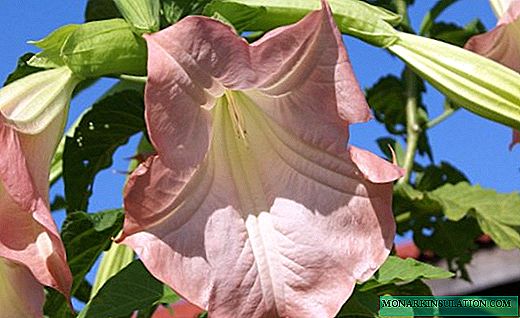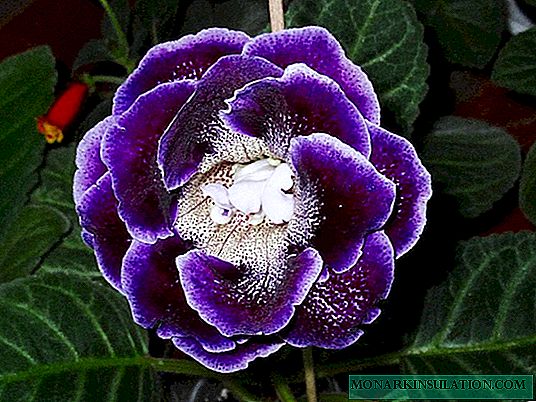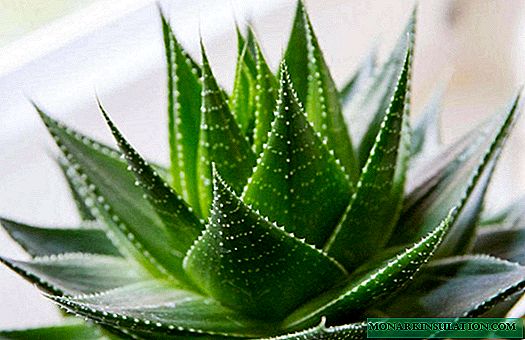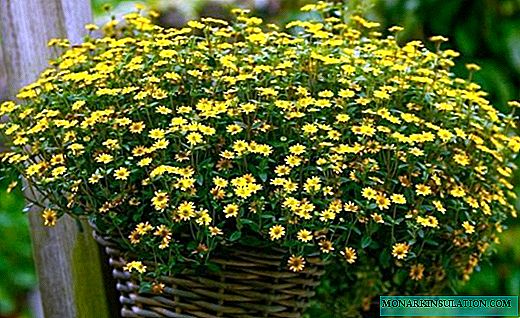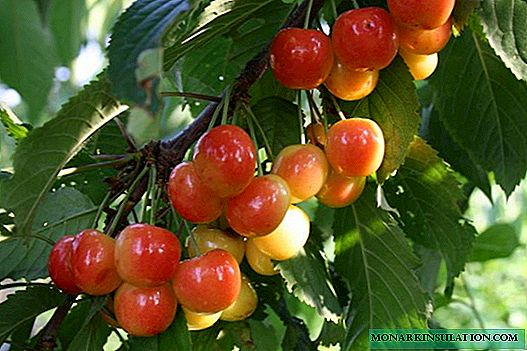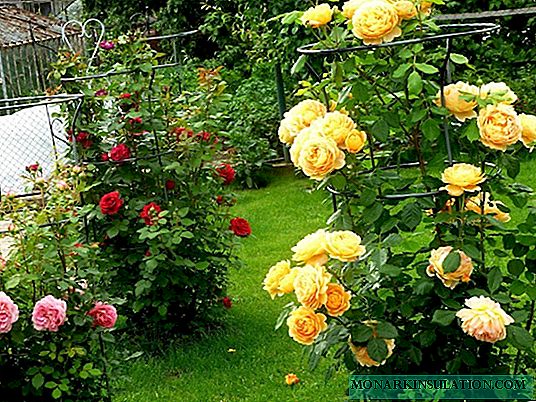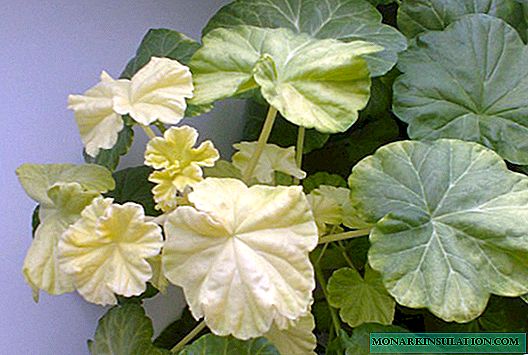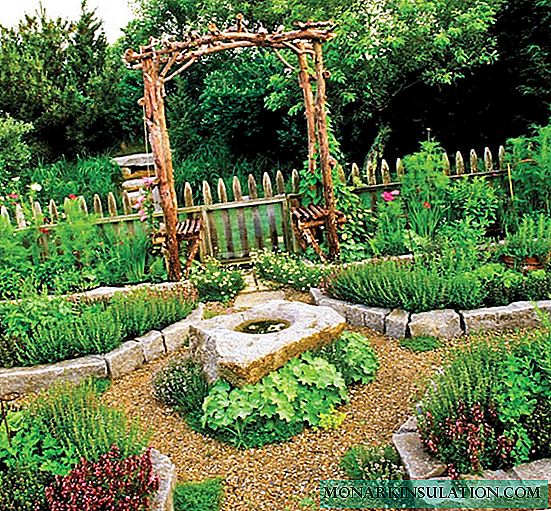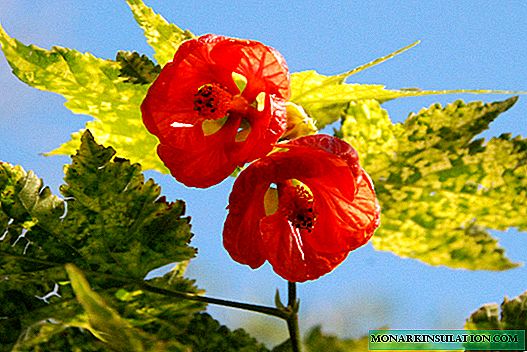
August dew is a summer pear variety. She received many of her advantages from an overseas parent who has held a strong position in the global market for over 100 years. The second, our parent, added her resistance to frost and disease.
Grade description
The Augusta dew pear variety was bred in the city of Michurinsk at the All-Russian Scientific Research Institute of Genetics and Fruit Plant Breeding in 1997, and in 2002 it was brought to the State Register and zoned in the Central Black Earth region. The variety was obtained by crossing the pear Tenderness, which served as a source of high winter hardiness and immunity to diseases, and the Australian Triumph Pakgama variety. The latter was obtained back in 1987 and to this day continues to be one of the leading commercial varieties in Europe. From him the August dew received such qualities as:
- short stature
- early maturity
- productivity
- great taste of fruits.
The tree is stunted (no more than 3 m), fast-growing, with a thick drooping crown. Arcuate, smooth, light brown shoots extend from the trunk almost at right angles. Fruit buds are laid mainly on the spears and gloves.
The tree begins to bear fruit in the 4th year. Winter hardiness is high, frost resistance is up to -36 ° C. August dew has good immunity to the main fungal diseases - scab and Septoria.
The fertility of the variety is low. The best pollinator, experts recognize the pear variety in Memory of Yakovlev.

In the 4th year after planting the August dew, they receive the first fruits
Productivity is high and annual. Over the years of state variety testing (1997-2002), this indicator was at the level of 156 c / ha.
The shape of the fruit is short-pear-shaped, average weight - 130 g. The skin color is yellowish-green, without blush, with a large number of subcutaneous dots. The funnel sometimes appears slightly rusted. The pulp is white, delicate, fine-grained, juicy, with a pleasant sour-sweet taste. Tasting score - 4.5 points out of 5.

The color of the skin of the pear fruit August dew - yellowish-green
Fruits keep well on branches, do not fall off for a long time. Removable maturity occurs in mid-August, the term of consumption and storage of fruits - 2 weeks. Appointment of fruits is table. Marketability is high. The disadvantages of the variety include some heterogeneity of the fruits at high yields.
Pear planting
The conditions for the successful cultivation and fruiting of the August dew pear are:
- Lack of stagnation of water in the root zone. Wetlands and areas with high groundwater levels are excluded. This is due to the tendency of the pear to root out the root and the stem.
- Good lighting and ventilation in the absence of drafts and cold northerly winds.
- Loose, drained soil rich in humus. The acidity level is pH 5.5-6.0, in extreme cases, pH 4.2-4.4 is suitable. But on alkaline soils, the pear will hurt and will most likely die.
Summary: The best place to plant a pear is on the south or southwest slope with natural protection from the cold north and northeast winds. Dense trees, a fence or a wall of a building can serve as such a fence, but the pear should not be in their shadow.
Due to the small growth of the August dew tree, the distance between neighboring plants during group planting may be slightly less than usual. It is enough to observe the interval in the row of 3-3.5 m, and between the rows - 4-4.5 m.
In the Central Black Earth region - the August dew growing zone - seedlings are planted in early spring until the buds awaken. A tree planted at such a time will take root well in the fall and be strong enough.
Seedling selection and storage
Experienced gardeners acquire seedlings for spring planting in the fall. At this time, nurseries produce a massive excavation of planting material, which means that you can choose the best quality planting material. You need to give preference to seedlings at the age of 1-2 years.
For seedlings with a closed root system, age restrictions do not apply - at the time of purchase, they can be 3-5 years or more. You can land them at a permanent place at any time - from April to October.
When choosing a seedling, you need to make sure that the root system is well developed, without any cones and growths. The bark of the trunk and branches should be smooth, healthy, without cracks and other damage.

On well-developed roots there should be no growths and cones
For winter storage, the seedling is usually dug in the garden:
- The roots of the seedling are covered with a layer of talkers (creamy composition of clay, mullein and water) to protect them from drying out.
- Dig a hole with a depth of 30-40 cm and a length of 80-100 cm.
- A small layer of sand is poured into the bottom.
- Lay the seedling obliquely with its roots on the sand, with the tip on the edge of the pit.
- They fill the roots with a layer of sand and watered with water.
- Before the onset of cold weather, they fill the hole completely with earth. Only the top of the tree remains on the surface.

For winter storage, the seedling is usually dug in the garden
Landing pit preparation
A landing pit is a kind of food storeroom for a plant in the first years of its life. The poorer the soil, the larger the size and quantity of stocks should be pit. On average, its dimensions are 70-80 cm in diameter and in depth, but on sandy soils they increase to 100 cm or more.
At the bottom of the pit, drainage should be laid, which will avoid stagnation of water on heavy soils. This layer of broken brick, crushed stone or expanded clay should be 10-15 cm thick.
On sandy soils, instead of drainage, a clay layer is laid to retain moisture.
Prepare a nutrient mixture consisting of equal parts of chernozem, peat, humus, sand. Before mixing the components, 300-400 g of superphosphate and 3-4 l of wood ash are also added. With the mixture, the pit is filled to the top, and then covered with some waterproof material so that melt water does not wash out the nutrients.
Step-by-step instructions for planting a pear
Seedling Planting Algorithm:
- Dig a plant and examine its condition. If damaged roots are found, they are cut out with secateurs.
- Soak the roots for several hours in the water, you can add there Kornevin, Heteroauxin, Epin or other growth and root stimulants.
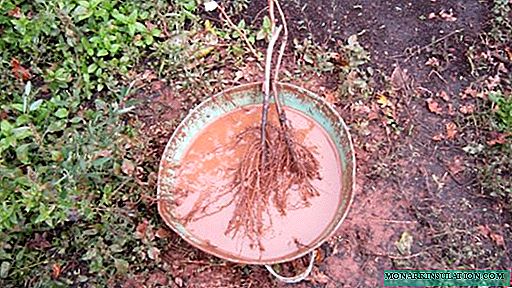
Before planting, the roots of the seedling are soaked in water
- The planting hole is opened and part of the nutrient mixture is removed from it so that a hole is formed in the center for free placement of the root system of the seedling in it.
- At a distance of 10-15 cm from the center, a wooden stake is driven in (90-120 cm high above the soil level).
- Pour a small mound in the center of the pit.
- A seedling is placed in the pit so that its root neck is at the top, and the roots are on the slopes of the knoll.
- They fill the hole with excavated soil. It is more convenient to do this together - one is holding a seedling, and the other is falling asleep and leveling the earth in layers.
- The seedling is tied to a peg with any elastic material. It is forbidden to crush the bark of a tree.
- To retain water during irrigation, a near-trunk circle is formed around the tree, raking an earthen roller along the diameter of the landing pit.
- Water the trunk circle so that the soil is well moistened and as a result fits snugly against the roots. Also, air sinuses in the root zone, which inevitably form when backfilling, should be eliminated.
- The central conductor is cut off at a height of 60-80 cm from the ground, and the branches are shortened by half.
- After a few days, the soil is loosened and mulched with humus, rotted sawdust, hay, etc.

A few days after planting, the soil is loosened and mulched.
Features of cultivation and subtleties of care
When growing a pear, it is enough for the gardener to know the usual agricultural practices and methods for caring for fruit trees.
Watering
Regular watering should provide a constant level of soil moisture in the near-stem circle to a depth of 15-25 cm. If there is not enough moisture, the pear can begin to shed ovaries and fruits. But in the basal zone there should not be a “swamp”, as this will lead to the root and stem sap. To protect the trunk before watering, a small earthen roller should be heated around it, which will protect it from direct contact with water.
Watering is usually started in the spring, when the soil begins to dry. As a rule, this happens before the pear begins to bloom. Subsequently, watered if necessary - usually every 2-3 weeks. After watering, the soil should be loosened and mulched.
Some gardeners mulch pears during the first spring irrigation, and later water the soil through a layer of mulch. To maintain moisture, the intervals between irrigation are increased, and weed growth is also blocked. The only drawback of this method is the fact that slugs, rags and other pests can start in the mulch. They should be collected and destroyed, if necessary, treat with insecticides. Fit:
- Decis
- Fufanon,
- Spark,
- Spark Bio and others.
The soil should be dried, and pour new mulch after the next watering.
Top dressing
With a lack of nutrition, the pear can also lose fruit, as well as with a lack of water. Typically, such a deficit occurs 3-4 years after planting. This means that the supply of food in the landing pit has been depleted and regular feeding should be started.
Table: types of fertilizers, terms and methods of application
| Top-up dates | Types of fertilizer applied | Dosage and Interval | Application Methods |
| March, April | Organic fertilizers (humus, compost, peat). | Once every 3 years in the amount of 5-7 kg per 1 m2. | Close up in the soil when digging. |
| Mineral nitrogen fertilizers (nitroammophosk, urea, ammonium nitrate). | 20-30 g per 1 m annually2. | ||
| May June | Mineral potash fertilizers (potassium monophosphate, potassium sulfate). | Annually in the amount of 10-20 g per 1 m2. | Dissolve in water during irrigation. |
| June July | Liquid organic infusions. | 1 liter of concentrate per 1 m2. During the summer, make 3-4 times with an interval of 2-3 weeks. | A concentrated infusion is made by holding in a warm place 2 liters of mullein, filled with a bucket of water. Instead of mullein, you can apply 1 liter of bird droppings or 5-7 kg of fresh grass (weeds can be used). Dilute the concentrate with water in a ratio of 1:10 and water the pear. |
| October | Mineral phosphate fertilizers. | 20-30 g per 1 m annually2. | Close up in the soil when digging. |
| Complex mineral fertilizers are applied, guided by the instructions for use. | |||
Pruning
The tree near the August dew is stunted, so the crown shape in the form of an improved bowl is chosen. Such a crown is well ventilated, illuminated, it is easy to care for and harvest:
- After 1-2 years in early spring, 3-4 best branches are selected on the trunk, which should be located with an interval of 15-20 cm and grow in different directions. These are future skeletal branches - they are cut off by 30-40%. The remaining shoots are cut into a ring. The central conductor above the base of the upper branch is also cut off.
- After 1-2 years, branches of the second order are formed. For this, on each skeletal branch, two shoots are selected located at a distance of 50-60 cm from each other. They are cut in half, the remaining branches are cut into a ring.

Since the tree near August dew is stunted, it is better for her to choose the shape of the crown in the form of an improved bowl
Adjust cropping
Next, you need to adjust the length of the branches so that they are equivalent, and not one of them takes on the role of the central conductor. Also, the crown is periodically thinned out, since the August dew is prone to thickening, which prevents ventilation and good lighting. At the same time, those shoots that grow inside the crown are removed. Such pruning is called regulatory. It is carried out in early spring.
Support Crop
The purpose of this pruning is to maintain high tree yields. In a simplified version, it consists in shortening young shoots by 5-10 cm. This stimulates their branching with the formation of additional fruit branches, which sets the prerequisites for increasing the yield of next year. This method is called coinage. It is used in the summer during the growth period of young shoots.

More experienced gardeners are recommended a method of replacing prolific shoots with substitution shoots
Video: pruning young pear branches to form fruit buds
Sanitary pruning
This pruning is traditionally carried out in late autumn after the cessation of sap flow. At the same time, diseased, dry and damaged branches are removed, since various larvae can hide in their bark and fungal spores can be found. In early spring, if necessary, sanitary pruning is repeated if during the winter any branches have frozen out or were broken under the weight of the snow.
Cropping Rules
When pruning, the gardener must follow certain simple rules:
- Sharpen the tool sharply before cutting.
- The tool should also be disinfected. To do this, you can use a 1% solution of copper sulfate, alcohol or a 3% solution of hydrogen peroxide. Oil products (for example, kerosene, solvent, gasoline) should not be used - this can harm the plant.
- You can not leave knots or hemp after trimming - later they will become a refuge for pests and a hotbed of fungal diseases. Entire branches should be cut into a ring.
- Heavy, branched, bulky branches are removed in several steps in parts.
- Slices of branches, the diameter of which exceeds 1 cm, are peeled with a sharp knife and covered with a layer of a garden var.
Choose a garden varnish based on natural ingredients - lanolin, beeswax, etc. Petrolatum and other petroleum products that are part of most sold garden varieties can damage the tree.
Diseases and pests - the main types, prevention and control
The high immunity of the August dew to major diseases does not exempt the gardener from sanitary and preventive maintenance.
Prevention measures:
- Maintaining order on the site, timely weed removal, collection and disposal of fallen leaves, dry branches, etc. - these simple measures will deprive pest shelters, significantly reduce their presence.
- Monitoring the state of tree bark. Before leaving the pear in the winter, the bark should be examined, and if cracks and damage are found, heal them. To do this, such places are cleaned to healthy wood, then they are disinfected with a 1% solution of copper sulfate and covered with a layer of a garden var.
- Whitewashing trunks and thick branches with lime mortar. This not only decorates the garden, but also protects the bark from sunburn. Some caterpillars and bugs will not want to crawl through the limestone barrier - this will prevent them from getting onto the crown.
- Digging of the soil of near-trunk circles before the onset of frost. In this case, it is necessary to turn over the earth so that the pests that winter there are raised to the surface, after which they can die from the cold.
- Spraying the dug up soil and a tree crown with a 3% solution of copper sulfate. This will destroy the spores of fungi and insects. Such spraying is also useful to do in the early spring, before the sap flow begins. Instead of copper sulfate, you can use a Bordeaux mixture in the same concentration or a 5% solution of iron sulfate.

In late autumn and early spring, the pear is sprayed with a 3% solution of copper sulfate
- Installation of hunting belts on tree trunks in early spring. This measure will prevent the weevils, moth caterpillars, ants carrying aphids from getting on the crown.
- Pesticide treatment with DNOC and Nitrafen.The first is used once every 3 years, the second - in the remaining 2 years. These potent universal drugs are an effective measure for the prevention of all known fungal diseases and pests. After flowering, pears go on to use low-risk systemic fungicides. The most famous and popular:
- Coming soon
- Quadris,
- Horus
- Ridomil Gold and others.
As a rule, after three applications, the effectiveness of the drug is significantly reduced. Therefore, they need to be alternated, and immediately before harvesting, drugs with a short waiting period are used. For Horus, this period is 7 days, and for Quadris - 5. The processing interval is 15-20 days. They are especially important after rains, when favorable conditions are created for fungi.
Possible pear diseases and pests
Although the variety is immune to certain diseases, under adverse conditions they can still occur.
Table: What can a pear get sick
| Disease | Signs | Damage | Treatment |
| Scab | Olive-colored spots appear on the leaves. In the future, the fruits are affected, on which putrefactive spots, cracks are formed, the flesh hardens. | The fruits become unusable. Significant crop loss is possible. |
|
| Moniliosis (monilial burn) | During flowering, the pathogen enters the flowers with pollen brought by bees. Developing in flowers, the fungus further penetrates the shoots and leaves. The affected parts of the plant wither, twist, blacken. External signs resemble a burn or frostbite. During the period of growth and ripening of the fruit, the fungus infects them with gray rot, making them unfit for consumption. | It is expressed in the loss of part of the shoots and fruits. With significant spread, the whole tree may die. |
|
| Soot fungus | Affected leaves and fruits are covered with a black coating resembling soot. As a rule, the appearance of this fungus is preceded by an aphid attack. Its sweet discharge is a breeding ground for soot fungus. | The fruits become unusable. Significant crop loss is possible. |
|
Photo Gallery: Major Pear Diseases
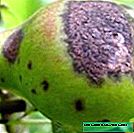
- Putrid spots form on the scab affected pear

- During the period of growth and ripening of pear fruits, moniliosis affects them with gray rot
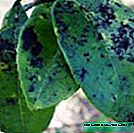
- Pear leaves affected by a soot fungus are covered with a black coating resembling soot
Table: Probable Pear Pests
| Pests | Signs of attack | Damage | Ways to fight |
| Aphid | The appearance of aphids can be determined by folded leaves. Having unfolded such a leaf, the gardener will see small insects of black, green, white and other colors - which means that the aphid has got on the pear. She can also settle on the tips of young shoots. It enters the crown with the help of ants, which introduce aphids in order to subsequently feed on its sweet secretions. | If you do not fight aphids, it can cause significant damage to the crown. |
|
| Pear beetle | Pear flowering winter in the soil of tree trunks. In early spring it rises to the surface, then into the crown of a tree. It is difficult to see due to the small size and timidity of the insect. The results of vital activity of the florist are yellowed, eaten flowers and buds. | If the pest is not prevented, then it is possible to lose not only the crop, but also significantly weaken the tree. | Insecticide treatments and preventative measures. |
| Pear moth | The butterfly lays eggs in the soil, caterpillars creeping out of them rise on the crown, gnaw holes in the fruits and eat them from the inside. Signs of damage are the appearance of holes on the fruits, as well as the shedding of such fruits. | Crop loss. | Only prevention. |
Photo Gallery: Pear Insect Pests

- Aphids are carried on a tree by ants

- Pear moth butterfly lays eggs in the soil
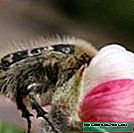
- Pear Blossom Eats Pear Flowers
Gardeners reviews
I am a beginner gardener, through trial and error I create my own garden. August dew this year gave its first fruits of 6 pieces, and a huge increase, branches like weeping willow to the ground.
tavis. Moscow region
//forum.prihoz.ru/viewtopic.php?t=4591&start=1395
Varieties August dew and Memory of Yakovlev are rather self-fertile, they will bear fruit without an external pollinator.
AlexanderR, Nizhny Novgorod region
//forum.prihoz.ru/viewtopic.php?t=4591&start=1395
August dew In 2014, it was frozen, there was no crop. In the past 2013, the harvest is plentiful. Ripens in our conditions in September. The fruits are almost one-dimensional, there are no small ones. Delicious. Do not overripe on the tree, mature fall. Great variety!
Boykivchanin, Carpathians
//forum.vinograd.info/showthread.php?t=10426
August dew is one of the most beloved pears in our family. A small, neat tree. Hassle-free in terms of winter hardiness, drought tolerance, resistance to diseases and pests. Standard care is enough for him. Pears measured, aligned - 130-150 grams. A very harmonious combination of acid and sweetness (not fresh, sweet, which I don’t like in pears). Very juicy with tender, melting flesh. Especially good if removed on time and at least a week put in the basement. Then the aroma is more pronounced, spice appears in the taste. Ripens in our conditions in the second half of August. A wonderful variety with one but serious flaw - it is always not enough. I would eat and eat, but it quickly ends! I want to plant another tree.
Apple, Belgorod
//forum.vinograd.info/showthread.php?t=10426
Pear August dew attracts with annual and high productivity, winter hardiness, immunity to diseases, early maturity. She has one drawback - nature took too little time to enjoy the wonderful taste of fruits. Only 2 weeks of pleasure - but worth it.












